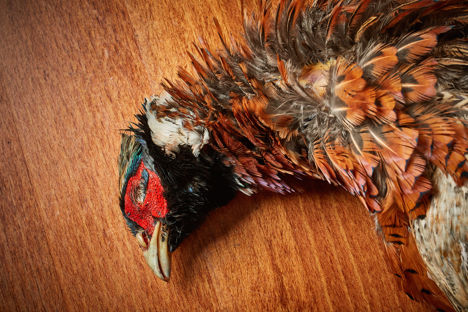Of all the game birds that can be found across the UK in autumn and winter, pheasant is the most common. But while we might see the pheasant as a symbol of the Great British countryside, it’s actually a native of Asia. They were introduced to Europe (and eventually the UK) by the Romans, and started to become popular in Britain from the eleventh century onwards. They breed easily and adapt to climates well, making them the perfect game bird – today as many as 35 million pheasants are released into the wild each year.
Pheasant is a small, lean bird that’s prone to drying out, so it deserves extra care and attention during cooking. The taste is compared to chicken and guinea fowl, with varying amounts of ‘gaminess’ depending on how aged the bird is.
What to look for when buying pheasant
The open season for hunting pheasant in the UK is 1 October to 1 February, so any pheasant you find outside of this period will most likely be frozen. Choose a hen (female pheasant) over a cock (male) as they have plumper bodies which are less likely to dry out. Older birds are slightly tougher and more suited to slow-cooking in casseroles or pies, whereas new season birds are perfect for roasting.
Birds shot in the head are highly preferable. If the shot goes through the stomach or intestine, the bird is unsuitable for hanging (which tenderises the meat), therefore they tend to be tougher and only really suitable for stewing. If the innards break and contaminate the meat it can also impair the flavour.
To help tenderise game birds, they are ‘hung’, with innards and feathers intact for three to ten days. The time tends to depend on temperature; 10°C is generally regarded as the best ambient temperature. During this time, the enzymes and tissues begin to break down, giving that characteristic gamey flavour and making the meat less tough.
If you happen to have bought a completely fresh pheasant that has yet to be hung or plucked, hang it in a cold shed (away from a fox’s grasp!) for 3-7 days. It’s more likely that you’ll have bought a ready-plucked pheasant from a butcher, however. These will be ready to eat right away, but be sure to remove any cling film when you get the bird home to stop it from collecting moisture, as this can affect the taste.
How to cook pheasant
One whole pheasant is generally the right size to feed two people. Younger hens should be cooked slightly pink, so are ideal for pan-frying or roasting. Wrapping the bird in bacon or pancetta is a tasty way of keeping the bird nice and juicy and preventing it from drying out. Brining is also a good way of helping the bird retain its moisture, plus you can season the bird by making a delicious brine full of spices.
A pheasant's firm, lean flesh means it can dry out easily, so a failsafe way of cooking it is in casseroles or stews – this is particularly true of larger, older birds. Remove the breasts and legs from the carcass and make a stock with the bones which you can then use to braise your pheasant in.
Follow the simple recipe below for roasting 2 pheasants (enough to to serve four).
Metric
Imperial
- 2 pheasants, hung, plucked and oven-ready
- 4 slices of streaky bacon
- 1 sprig of rosemary
- 1 bay leaf
- 1 carrot, peeled and chopped
- 1 onion, peeled and chopped
- 1 celery stick, chopped
- 2 garlic cloves, peeled
- 100ml of chicken stock, or water
- vegetable oil
- salt
- freshly ground red pepper
- butcher's string
Preheat an oven to 200°C/gas mark 6
Cover each of the pheasants with 2 slices of the bacon and truss with string. Season the cavity of the birds with a pinch of salt and pepper
- 2 pheasants, hung, plucked and oven-ready
- 4 streaky bacon
- butcher's string
- salt
- freshly ground red pepper
Heat the vegetable oil in a large roasting pan and brown the pheasants on all sides
- vegetable oil
Arrange the carrot, onion, celery, garlic and herbs around the birds and add the stock. Roast in the oven for 25–30 minutes, basting frequently
- 1 carrot, peeled and chopped
- 1 onion, peeled and chopped
- 1 celery stick, chopped
- 2 garlic cloves, peeled
- 1 sprig of rosemary
- 1 bay leaf
- 100ml of chicken stock, or water
Remove from the oven and turn the birds upside-down to rest for 10 minutes before carving and serving
How to serve pheasant (and what to serve it with)
Terrines, pies and pithiviers
A good use of the legs is in terrines and pies, served with spiced winter fruit chutneys.
Roast pheasant
Spiced pheasant
As a quintessential British game bird, we tend to associate pheasant with British ingredients – but the bird's strong gamey flavour means it can stand up to bold spices too. This is illustrated beautifully in Vineet Bhatia’s Achari pheasant recipe which sees the bird marinated not once, but twice in garlic, ginger, yoghurt and a whole host of spices. This not only flavours the meat but the enzymes in the marinades help to tenderise it too. For another twist, Joe Fox pairs his roast pheasant with a delicately spiced madeira sauce using star anise, cinnamon and allspice.
Kentucky fried pheasant
Pheasant’s flavour and texture is often compared to guinea fowl or chicken and it can be treated similarly. It is used here as a twist on the traditional fried chicken recipe; deep-fried in a spiced flour coating for that delicious crunchy, craggy texture.
Get in touch
Please sign in or register to send a comment to Great British Chefs.


